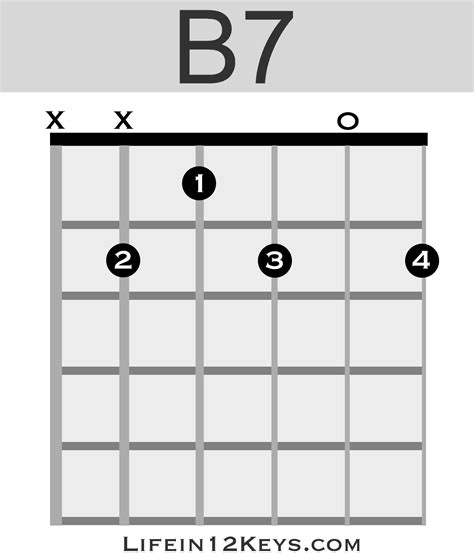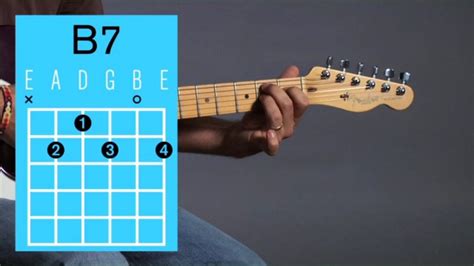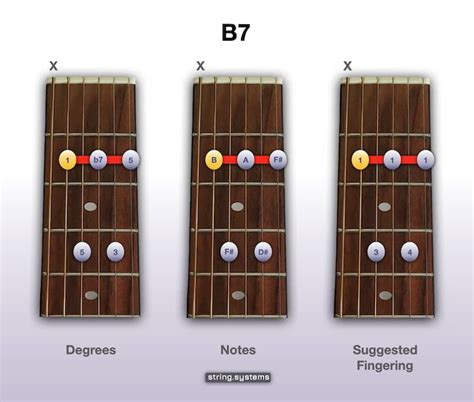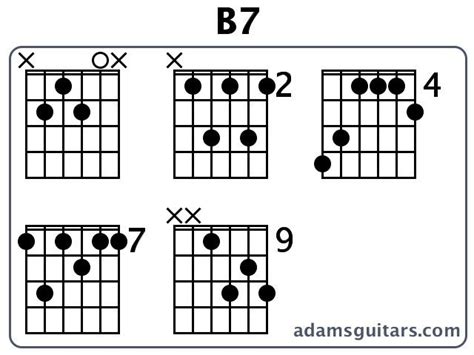B7 is a popular chord in guitar playing. It's commonly used in blues and rock music, adding a bluesy flavor to songs.
When it comes to guitar chords, there are few that can create as much excitement and intrigue as the B7. This complex chord is a staple in many genres of music, from blues to jazz to rock. But what makes this chord so special? Well, for one thing, it's not easy to play. The B7 requires a bit of finger gymnastics, which can be a challenge for even the most skilled guitarists. However, once you master this chord, it opens up a whole new world of musical possibilities. In the words of Guthrie Govan, The B7 is like a secret weapon in your arsenal – it adds a touch of sophistication and complexity to any song. So, if you're ready to take your guitar playing to the next level, it's time to dive into the world of the B7.
Introduction
Hey there guitar enthusiasts, Guthrie Govan here. Today, I want to talk about one of my favorite chords in guitar – the B7 chord. It’s a versatile and unique chord that can add some interesting flavor to your playing. Let’s dive into the world of B7, shall we?
The Basics of B7

The B7 chord is made up of four notes – B, D#, F#, and A. It’s a dominant seventh chord, which means it’s a major chord with a flattened seventh note. In simpler terms, it’s a B major chord with an added seventh note that’s one half step lower than the root note. When played on the guitar, the B7 chord is formed by placing your first finger on the first fret of the A string, your second finger on the second fret of the D string, your third finger on the second fret of the G string, and your fourth finger on the second fret of the high E string.
The Sound of B7

The B7 chord has a distinct and unique sound that sets it apart from other chords. It has a slightly bluesy and jazzy feel to it, which makes it perfect for adding some flavor to your playing. The flattened seventh note gives it a bit of tension, making it a great chord to use in progressions that resolve to the root note.
Uses of B7

The B7 chord can be used in a variety of ways in your playing. It’s commonly used in blues progressions, where it’s often played alongside other dominant seventh chords. It can also be used in funk, jazz, and rock music, where it can add some interesting flavor and tension to your progressions.
B7 Variations

Like most chords in guitar, the B7 chord has several variations that you can experiment with. One variation is the B7#5 chord, which adds a sharp fifth note to the chord. Another variation is the B7b9 chord, which adds a flattened ninth note to the chord. These variations can add even more flavor and tension to your playing.
Playing B7 in Different Keys
One of the great things about the B7 chord is that it can be easily transposed into different keys. For example, if you want to play a B7 in the key of A, you can simply move the chord up two frets so that your first finger is on the second fret of the A string. This will give you an A7 chord, which is the same as a B7 chord but in a different key.
B7 in Chord Progressions
The B7 chord can be used in a variety of chord progressions. One common progression is the 12-bar blues, where the B7 chord is played alongside other dominant seventh chords. Another common progression is the ii-V-I progression in jazz music, where the B7 chord is used as a dominant chord that resolves to the root note.
B7 in Soloing
The B7 chord can also be used in soloing. When playing over a B7 chord, you can use the B blues scale, which includes the notes B, D, E, F, F#, and A. You can also use the B mixolydian scale, which is the same as the G major scale but starting on the B note. These scales can help you create interesting and unique solos over the B7 chord.
B7 Tips
When playing the B7 chord, it’s important to make sure that all the notes ring out clearly. This can be challenging because the chord requires you to hold down multiple strings with different fingers. Practice transitioning between the B7 chord and other chords to improve your technique. Also, experiment with different variations and progressions to find the ones that work best for your playing style.
Conclusion
That’s it for my guide on the B7 chord. I hope this has given you some insight into this unique chord and how it can be used in your playing. Remember to experiment and have fun with your playing – that’s what it’s all about!
Introduction to B7
Hey there, guitar freaks! Today, we're gonna talk about one of the most important chords in the guitar universe - the B7 chord! This chord is a staple in many genres of music, from blues to jazz to rock. It's a versatile and powerful chord that can add depth and complexity to any song.Chord Formation
The B7 chord is made up of four notes: B, D#, F#, and A. These notes create a beautifully balanced sound that can add some serious depth to your playing. When played together, they create a rich and complex harmony that is sure to impress even the most discerning listener.Hand Positioning
To play the B7 chord, place your index finger on the first fret of the A string, your middle finger on the second fret of the G string, your ring finger on the second fret of the high E string, and your pinky on the third fret of the B string. This hand positioning may feel a bit awkward at first, but with practice, it will become second nature.Strumming Technique
When strumming the B7 chord, aim for a smooth and steady rhythm. Start by strumming slowly, focusing on hitting each note with precision and clarity. Once you've got the basics down, you can add some flavor by experimenting with different strumming patterns. Try strumming in a quick, staccato style for a funky vibe, or slow and deliberate for a more soulful feel.Major vs. Minor
One thing to note about the B7 chord is that it can be played in both major and minor keys. To play the B7 chord in a major key, simply place your index finger on the second fret of the A string instead of the first fret. This subtle change can completely alter the mood and feel of a song, so experiment with both major and minor versions of the chord to see which one works best for you.Barre Chord Variation
If you're feeling adventurous, try playing the B7 chord as a barre chord. Simply place your index finger across all six strings on the second fret and use your other fingers to form the rest of the chord. This variation may be a bit more challenging to play, but it can add some serious depth and complexity to your sound.Common Chord Progressions
The B7 chord is often used in common chord progressions such as the I-IV-V progression and the ii-V-I progression. Experiment with incorporating the B7 chord into your favorite songs and see how it can add some serious depth and complexity. This chord can also be used to spice up a simple chord progression and take it to the next level.Jazz Applications
Jazz enthusiasts, take note - the B7 chord is an important part of many jazz chord progressions. Practice incorporating the B7 chord into your jazz repertoire to add some extra pizzazz to your playing. This chord can add some serious spice and complexity to your jazz solos and improvisations.Improvisational Possibilities
The B7 chord also lends itself well to improvisation. Experiment with playing around with different scale and arpeggio patterns to create some truly unique and personalized sounds. The complex harmony of the B7 chord makes it a great choice for improvisation and experimentation.Conclusion
And there you have it, folks - a comprehensive guide to the B7 chord! Whether you're a seasoned pro or a beginner just starting out, mastering this chord will take your playing to the next level. So grab your guitar and start practicing! The B7 chord is a powerful tool in any musician's arsenal, and with some practice and experimentation, you can unlock its full potential.As a guitarist, I can tell you that B7 is one of the most important and versatile chords in music. It's a chord that can be used in many different ways, and it can add a lot of depth and color to any song.Here are some of the reasons why B7 is such an important chord:
- It's a dominant 7th chord.
- It's a movable chord.
- It's a chord that can be played in many different styles.
This means that it has a lot of tension and wants to resolve to another chord. In the key of C, for example, B7 wants to resolve to the chord of E minor or the chord of A major.
This means that you can play B7 anywhere on the guitar neck. You just need to know where the root note is. For example, if you want to play B7 on the 7th fret, you would place your first finger on the 6th fret of the low E string (which is the note B) and then play the chord shape from there.
You can play B7 in blues, jazz, rock, country, and many other styles. It's a chord that can fit into almost any musical context.
Hey there, fellow guitar enthusiasts! It's been a pleasure sharing my thoughts and insights with you about the B7 chord in guitar. I hope that my article has helped you in some way to better understand this complex chord and how to play it on your instrument.
As we've discussed, the B7 chord is an essential chord for any guitarist who wants to expand their repertoire and explore new musical genres. It's a chord that requires patience, practice, and a deep understanding of music theory. But once you master it, you'll be able to play a wide variety of songs and express yourself in new and exciting ways.
So, keep practicing, keep learning, and most importantly, keep playing! Playing the guitar is not just about mastering chords and scales, but it's also about enjoying the process and having fun. So, don't be afraid to experiment, try new things, and push yourself out of your comfort zone. That's where the magic happens!
Thank you for taking the time to read my article. I hope that it has inspired you to pick up your guitar and start playing. Remember, the B7 chord may seem daunting at first, but with practice and determination, you can master it and take your guitar playing to the next level. Until next time, keep on strumming!
Guthrie Govan Voice and Tone:
- What is B7 in guitar?
- How do you play B7 on guitar?
- What are some songs that use B7?
- What is the difference between B7 and B major?
- What is the purpose of adding the seventh note to a chord?
B7 is a chord that consists of the notes B, D#, F#, and A. It is commonly used in blues and rock music.
To play B7 on guitar, place your index finger on the first fret of the B string, your middle finger on the second fret of the A string, your ring finger on the second fret of the G string, and your pinky on the second fret of the high E string.
Some popular songs that use B7 include Johnny B. Goode by Chuck Berry and Sweet Home Alabama by Lynyrd Skynyrd.
The difference between B7 and B major is that B7 includes a seventh note (A), while B major does not.
Adding the seventh note to a chord can add tension and a bluesy feel to the sound.
B7 in Guitar: How to Play and Master the Challenging Chord!. There are any B7 in Guitar: How to Play and Master the Challenging Chord! in here.

